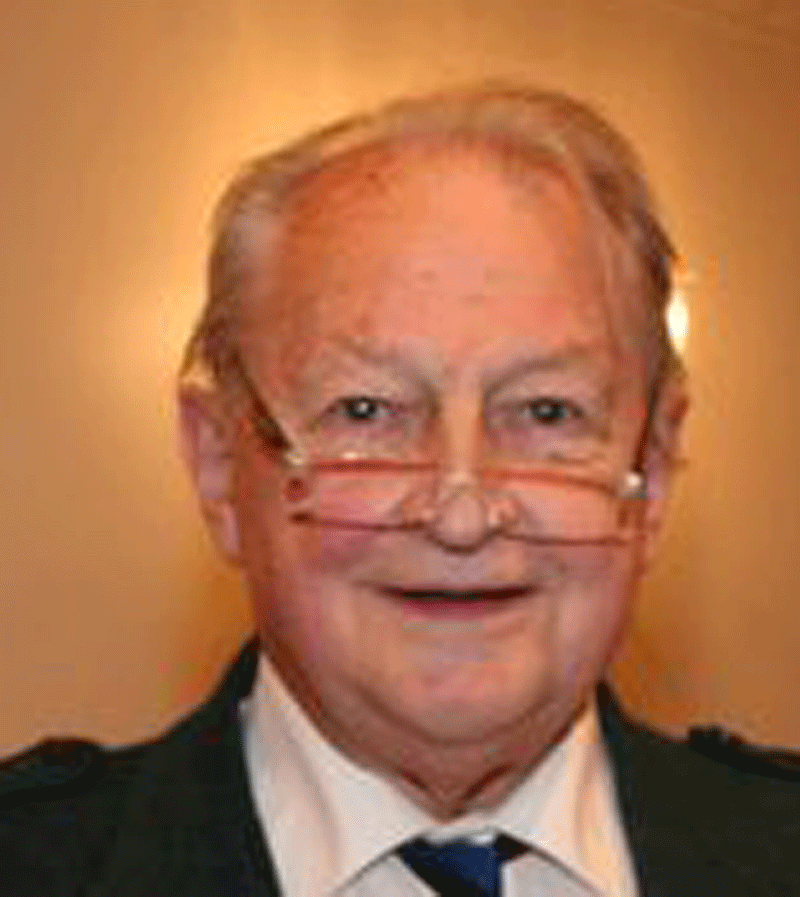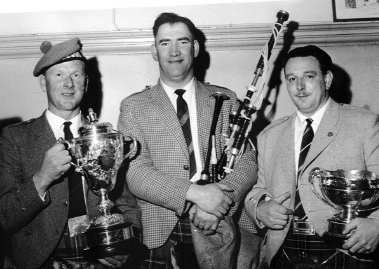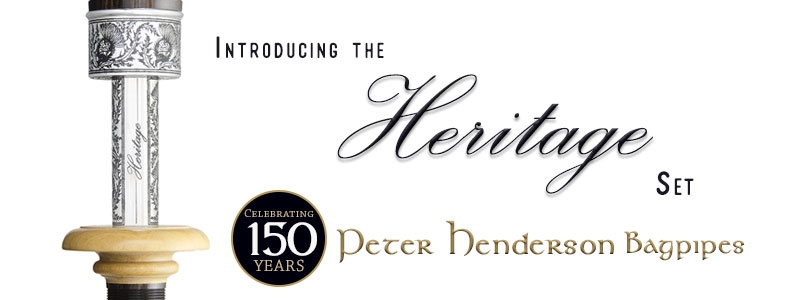Robert Wallace writes: A couple of years ago, when his illness first struck, I got talking to Angus about his life. My, how it was interesting! At the end of the chat I told him that he must write something down and, Angus being Angus, did just that – and for my benefit always with a piping bent. What follows is all the more touching now that he’s gone.
I have appended a tribute kindly forwarded by Ian Tegner, a family member who knew Angus well and who addressed the congregation at his funeral in October. For those who are unaware, Angus was a central figure in the solo piping world for most of his life being deeply involved with the Argyllshire Gathering, the Scottish Piping Society of London, the Highland Society of London and also as Piping Correspondent for The Times. A fluent Gaelic speaker, Angus also did some work on piobaireachd titles, their provenance and pronunciation. This will be published in due course.
My Life
by Angus Nicol

We lived in Scotland until a few days before war broke out. My family was based at Kilninver, about 10 miles south of Oban, where my grandparents lived. Although my immediate family, in order to be handier for Glasgow, lived in a number of other places (e.g. Wemyss Bay, where we had ringside seats watching the great liners, the Queen Mary and Queen Elizabeth, doing their speed trials over the measured mile), our centre of gravity was always Kilninver. I first attended the Oban Games in 1936. At that time, I must have heard some notable pipers, though I was unaware of who they may have been. They must have included the Bobs of Balmoral and many others. All the piping events, Gold Medal and Senior Piobaireachd included, were held on the Games field in those days.
We moved south just before WW2 began ‘knowing’ that we would be back in Scotland perhaps by Christmas, but in any event within six months. It was popularly believed that that was how long the war would last. How wildly wrong everyone was! During the Battle of Britain we lived near Biggin Hill in Kent and were able to watch most of the war in the air. Thereafter we lived in Wiltshire with my mother’s parents for nearly all of the war years. They had just (1938) retired from India where my grandfather had been running the East India Railway. He had lived in India since about 1895, and he and my grandmother were wholly unaccustomed to life in England – and to life without a household of 30-odd Indian servants, so we had to stay with them to help establish them in their new surroundings.
I was given a practice chanter and a copy of Logan’s Tutor for my ninth birthday. I was delighted with this, but found it very difficult to understand exactly what to do with my fingers without a live instructor. We searched high and low for such a being but in the south of England during the war we could not find even an aged retired pipe major to help me. I did not, therefore, get very far. I do, however, remember being fascinated by the canntaireachd of ‘the famous piobaireachd, ‘Cha Till MacCruimein’ [pronounced ‘Cha tcheel machk creemain’, the first ‘Ch’ as in loch] as Logan called it, and I tried singing it no doubt with wholly wrong pronunciation. Even after that, I had no real opportunity of learning the pipes.
I went to the Royal Naval College at Dartmouth at the age of 13. My first term was January to March 1947, a winter which would make any recent bad one look like spring. However, we weathered that – with the aid of compulsory cold baths every morning. Had I been reasonably proficient on the pipes by then it would probably have been tolerated as an unusual eccentricity. But at an early learning stage I am sure it would have been considered to have been an antisocial act. So I never properly learned, until many decades later I endeavoured to teach myself on that same chanter. I have once tried playing the bagpipe, an experience which must have been as frightful to the audience as it was even to me[wds id=”6″]
I served in the Navy until 1956, as a midshipman and then sub-lieutenant, serving in the Mediterranean, in home waters, and in the Arctic in the Fishery Protection Squadron. We spent most of our time between Aberdeen, Iceland, Norway, and Bear Island (about 100 miles north of Norway), with occasional brief visits to Hull and Portsmouth. We lived on delicious fish, straight out of the water, and watched the Aurora Borealis by night.
I came out of the navy in 1956, since ships were becoming scarce, and I did not want to sit behind a desk for the next few years. In the meantime, I was a publisher’s editor, a farm hand, and a barman. Then I began reading for the Bar [legal examinations], and eventually was called to the Bar in 1963. I had maintained all my links with Argyll, which I visited as often as possible, usually three or more times a year, for a total of about ten weeks in the year. I became a Member of the Argyllshire Gathering in 1966, and was invited to be a Steward in 1976. I took over as Piping Steward the following year, and so remained until I became Senior Steward in 1982. After my year as Vice-President in 1983, I had a few years off, before being hauled back to be Piping Steward again. That period of office covered the difficult time when the Association of Piping Adjudicators was new and active, and when (January 1994) the Joint Committee for Judging was formed, of which I was a founder member.
In about 1995, it was becoming noticeable that there were very few young up-and-coming pipers in Argyll, except in Strachur and in the Campbeltown area. It became apparent that this was largely because there was no tuition in Argyll schools, except in those two areas. Strathclyde’s education authority was clearly not interested, and whenever a piping tutor retired or died that authority did not replace him. The transition of the local authority area back to Argyll from Strathclyde was taking place in 1996. I, as Piping Steward, was asked to see if something could be done about it. I approached the Education Department of Argyll and Bute District with a proposal that if the authority would provide tutors in primary schools the Argyllshire Gathering would find half the cost of so doing. I was delighted to find that there was an enthusiastic response locally, in what eventually became the Argyll & Bute Council. The Argyllshire Gathering Schools Piping Tuition Scheme has been going, and gathering momentum, since then. It started in the Oban primary schools, under the tuition of 6 ft. 6in. Ronnie Lawrie, who, I am told, terrified his young pupils until they came to realise what a kind and gentle person he was. Now the Scheme has extended to north Argyll, mid-Argyll, Knapdale, Islay and Mull. There is a gap between Lochgilphead and Kilmore, inclusive, which we hope to cover in due course.

In 1977 Seton Gordon decided to retire as Piping Correspondent of The Times, and finally gave it up in 1978. Iverach MacDonald was asked if he would take it on but was not prepared to travel to piping events and gave it up before the year was out. I was at that time one of the legal advisers to The Times, and the then Editor, Charles Douglas Home, whom I had come to know fairly well, asked me if I would like to do it. I accepted with enthusiasm. I started in 1979. That was the year in which, due to industrial action, The Times was not published for eleven and a half months. However, I still had to write the pieces, ‘just in case’. None of them was published until the competition season began again in 1980. When I started The Times devoted a great deal more space to piping than it did in Seton Gordon’s day. He was lucky if he got four column inches, and very rarely more. Nowadays most of my pieces are published online, and not in the paper itself, but just now and again, when they have nothing else to fill up the page they do spread a bit about Oban or Inverness, or even the Piobaireachd Society’s centenary, across the Court Page.
I had begun to learn Gaelic when I was in Malta, where I had found a copy (price 3d) of MacLafren’s Gaelic Self Taught. This is a very sound elementary grammar, of phenomenal dullness. I absorbed as much as I could of it, and when I came to London discovered that there were Gaelic classes to be had. I attended those for a couple of years, and then took over teaching the beginners and intermediates. I also joined Coisir Lunnainn (the London Gaelic Choir), in about 1976. I was conductor of that choir for six years in the late 80s and early 90s. I have done courses in both Gaelic language and Gaelic songs at Sabhal Mor Ostaig, in Skye (and elsewhere). Some of these were under the tuition of Morag MacLeod, from Scalpay (then of the School of Scottish Studies in Edinburgh University) who is, I should say, probably the greatest living authority on Gaelic songs. As a teacher she was demanding, a purist, a martinet, and very thorough. It was a revelation to be taught by her.[wds id=”2″]
Angus Nicol – a Personal Memoir
by Ian Tegner
Angus Nicol was born on 11th April 1933 and died 30th September 2016. His father was Harry Nicol and his mother Phyllis Eyers. They divorced when Angus was still quite young. His mother was a strong influence on Angus. He married but then separated – not divorced due to his traditional beliefs as a devout RC – long ago. He has two daughters: Catherine, a freelance travel journalist based in Hong Kong and Augusta, a teacher of English as a foreign language who now lives with her husband and two children in Vienna.
Angus and I spent many happy school holidays in and after war-time at Kilninver, shooting the masses of rabbits that plundered the land, fishing, walking, enjoying the generosity of our grandparents’ hospitality. Angus’ great love for Argyll was generated at that time and lasted passionately throughout his life. He went to Dartmouth aged 13 and joined the Navy. During his service he was able to enjoy playing both polo and rugby with some success, and excelled with a rifle. But the navy was not for him, and he extracted himself as soon as he could, eventually qualifying as a barrister.
In due course he concentrated on the arcane subject of Value Added Tax, and acted as chairman of many tribunals. In one case which hit the headlines he dismissed a demand by Her Majesty’s Customs and Excise to charge VAT on the generous tips paid to ‘dancing partners’ at a night-club. His judgements were invariably couched in most elegant language. The Angus we all knew was a man who focussed on a number of complex subjects. I think the words that describe him best to me are ‘erudite’, ‘intellectually rigorous’, ‘kind’, perhaps even ‘dogmatic’ – and all with a ‘delightful humorous touch’. [wds id=”29″]
An enthusiastic member of the Clan MacNicol, he participated in many of the clan activities taking place at Scorrybreac in his beloved Skye. A devout man, many years ago he embraced the Roman Catholic church, being a regular attender at Mass in Lochgilphead and at the Brompton Oratory in London. As in all things, he was a traditionalist, seeking inter alia to sustain the use of the Latin liturgy.
In his early days he was fascinated by ballet. In the nineteen-fifties he and I used to go to Covent Garden almost weekly – five shillings in the gallery – to see Margot Fonteyn and many other great dancers. He studied the music; he understood the Benesch system of dance notation; he knew the histories of each ballet. Indeed he once composed both music and choreography for a ballet, based on the Rime of the Ancient Mariner, in which he also danced the leading role. Around that time he developed an enthusiasm for heraldry, on which subject he could hold forth with considerable expertise; from that developed his elegant calligraphy, and I am sure that many of you have received missives from him set in the most beautiful script. His qualities were brought together to the greatest extent in later years in his focus on the Gaelic language and the music of the great Highland bagpipe.
He became a Gaelic scholar, respected by the authorities, regularly attending short courses at Sabhal Mor Ostaig in Skye, and amassing a significant collection of Gaelic literature. On my 50th birthday he composed for me, set in his beautiful calligraphy, a Gaelic poem, which he then kindly translated for me in elegant English verse. He was a core member of the London Gaelic Choir, which he conducted for many years. In 2004 he submitted a learned paper to the Holyrood Government on the necessity of making Gaelic into an official language in Scotland in the same way as Welsh enjoys that status. He had a few caustic things to say about Gaelic road signs.
In the field of piping, quoting the words of Robert Wallace, posted in the Piping Press on the day of Angus’ death: ‘He was a fixture at all the major piping events’. Although never a piper himself, he studied and mastered the complexities of the piobaireachd. He was for many years the piping steward of the Argyllshire Gathering of which he also served twice as Senior Steward. As a founding Trustee of the Argyll Piping Trust he initiated, in partnership with the Education Authority, the scheme to provide piping tuition in Argyll primary schools which has had such a transforming effect on Argyll piping.
He was the Piping Correspondent of the London Times, for which he also acted as a legal proof-reader. He was President of the Scottish Piping Society of London. He served for longer than anyone can remember as Secretary of the Highland Society of London, masterminding the considerable range of that organisation’s involvement in the piping world, and initiating the MacGregor Memorial competition held every year in Oban for young pipers from all over the world.
Angus was in many ways a very private person, but he was also kindly, inspirational, and generous with advice, comments and gems of information on his chosen subjects (often with an apt phrase in Gaelic). He will be remembered with affection and respect in many airts.



















Recent Comments